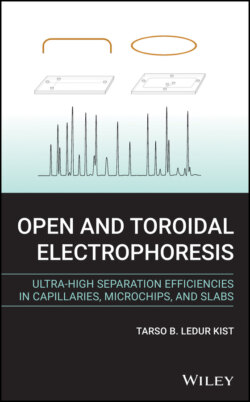Читать книгу Open and Toroidal Electrophoresis - Tarso B. Ledur Kist - Страница 18
1.1.6 Ionization
ОглавлениеWater molecules constantly collide with each other inside pure liquid water. In some collisions a proton of one water molecule attaches to the sp3 non-bonding orbital of a second water molecule, as given by: 2H2O → H3O+ + OH−. The generated ions (hydron and hydroxyl) are then immediately solvated and in a fraction of the events the solvated ions move apart as a cation (H3O+) and an anion (OH−), driven by thermal energy and facilitated by the low restoring force, which occurs because of the high relative permittivity of bulk water (equation 1.1). At a given temperature there is a constant rate of ion production and recombination (H3O+ + OH− → 2H2O), which leads to an equilibrium denoted by:
(1.3)
This phenomenon is the so called self-ionization of water, i.e. water itself undergoes ionization due to its remarkable properties (water falls victim to itself). Moreover, this reaction shows the amphiprotic nature of water, as it possesses both the characteristics of a Brønsted acid and base.
Molecules carrying acidic and basic functional groups are also subjected to ionization when introduced into water. For carboxylic acids (e.g., formic acid) there are at least two possible reactions for their ionization:
(1.4)
(1.5)
where the source of the OH− ions is the self-ionization of water. These can be seen as heterolytic substitution reactions; note that both H2O and OH− work as Brønsted bases in this case. For the ionization of amines (e.g., the secondary amine N-methylmethanamine) there are also at least two possible reactions that can occur:
(1.6)
(1.7)
Here, both H2O and the H3O+ cation function as Brønsted acids. For a detailed discussion of dissociation and ionization in water see Soustelle (2016).[4]
Finally, it is important to remember that a small fraction of the self-ionization reactions of water produce H5O2+ and an even smaller fraction produce H7O3+, as well as other ions.
A great deal of knowledge is continuously generated about the internal structure and dynamics of liquid water. Topics such as self-ionization of water, the ions produced, the average life-time of these ions, solvation, and water clusters are difficult to treat because they can not be treated as events in a continuous, homogeneous fluid. They should be treated within the many-body problem theories; however, the number of entities in the case of water must be great to be realistic because the water molecules are very sticky with each other due to hydrogen bonding. So one can always remember a saying that remains true: “Of all known liquids, water is probably the most studied and the least understood”.[5]
